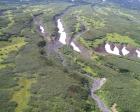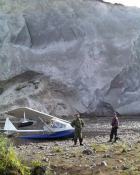
Picking a gorged mosquito off Chico's nose while she napped. John says
this is a expensive and complicated way to check their DNA because it
has the mosquito's DNA mixed up with it but I thought I had better get
some anyway when I could in case the post doesn't work.

Approach to a landing site on the side of a volcano. I landed to check
what I thought might be an abandoned poachers camp but it turned out to
be a volcanologist camp. I could tell when I looked because there were
rock samples left. This was September 1st and there are not many snow
drifts left to land on so I had to walk about a mile.

After I landed. The picture is deceptive: it is steep and narrow and I
was only able to land there because there is no wind and because I'm a
bit nuts.

I landed on a small river below a pumas cliff to talk to one of the Rangers
in the Kurilskoy Lake area. They get paid $25. US a month to fight poachers!
The second person in the picture is Bill Leacock, an American scientist
studying bear movements with satellite collars and lots of footwork. Bill
has been doing this for as long as we have been here. The fall of 97 he
and wife Tip and two girls stayed here with our cubs for three weeks the
first fall we had them while Maureen and I went back to Canada. That year
I renewed my visa and came back until December to see that they denned
OK.
(Click on any Image to see a higher resolution version)
I just got an e-mail from James, our webmaster asking if I am still alive. I realized that I have gone past some sort of deadline that we have established and am sorry for any of you out there who really are plugged into the Internet in an expectant way, waiting for word from this part of the world. We ourselves never look hook up with the net because it is so slow over the satellite and of course expensive so after so many months here what I write starts to feel repetitive, but James is constantly reminding me that there are interested people out there who actually read this stuff.
Fall is definitely here. We had frost weeks ago and the tundra will soon take on very colorful hues. There is some date in early fall that a feeling of urgency starts to emanate from bears. I'm sure it is an inner clock that sets off some sort of an alarm that is a count down the inevitable date when they have to dig a den and go underground for winter. This is very much a life and death situation for them. If they don't have enough fat to last them the six months until spring they die. For bears It is a wonderful trick that allows them to live in places such as this that have such brutal winters but bountiful summers. Years ago caribou migrated here for summer from the north where there is much less snow but they rarely stayed the winter. If they made a habit of it, a really hard winter would hit ( about every second or third year) and wipe them out. Now the herd is much smaller because of over hunting and those remaining never make it this far south. We see snow sheep on the mountains above the cabin but they too have a tough time because of the winters. People stay away for the same reason. Even the summers are a bit tough for most including us at times.
I can sense this urgency in the cubs after a date starting sometime around the middle of August. They get very purposeful. There just is no more time for fooling around. They are constantly on the move checking out the best options for putting on the most weight. From watching them closely over their lifetime, they really only have about three months to put on the fat they need for survival. When they come out of the den they are still fat. Throughout May and June they rely on that residue fat to coast them through the slow time in spring when it seems to take so long for anything to grow at this elevation. Ordinarily, their mothers would take them down to the east coast for a month where spring comes early at sea level. The lush vegetation that does grow quickly in July and half of August, really only maintains their weight. The salmon, pine nuts and berries are what finally give them what it takes to pack it on.
This year everything is slow coming on for them. Those three things are at least two weeks behind normal so I can see that they are struggling. However, I can also see that they will probably be OK because there are a lot of salmon in the lake about to be available to them (I hope!). I guess it will depend on how much competition they have from other bears when it happens. I have never seen so many berries and there is a reasonable pine nut crop, although the salmon and pine nuts are nothing like they were last year.
Right now the cubs are off somewhere eating crow berries and green pine cones I think. I lost track of them during a storm that just blew through but I see scats full of these things from other bears wandering though and I'm quite sure they monitor that too.
Before the storm, I did some flying to see if I could detect any poaching in the Preserve. There was some calm, clear weather for a few days which gave me the window to have a good look. I fly early and late to spot smoke from their camp fires. This is part of a way that we are helping put a stop to the caviar poaching and bear gall bladder poaching that has gone on in the past. The summer started out bad for caviar thieves but now is much better. The health of the salmon production is critical for brown bears. The Asian gall trade is at a low for some reason right now so there is little pressure there as well.
My brother John gave me some advice as to how I might collect some hair samples for DNA of the cubs. It involved digging a post into the ground along the beach trail to make a rub site for bears. On the post I put a piece of sheet metal with some hair snags on it to pull out little tufts by the roots. They haven't used it yet.